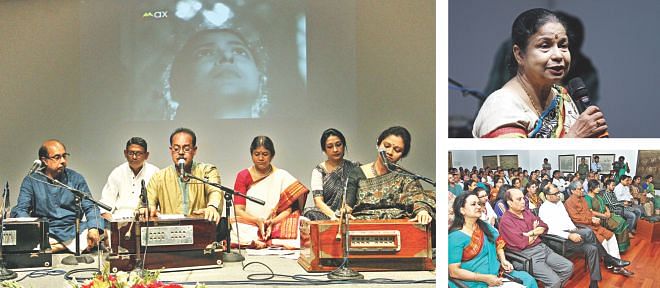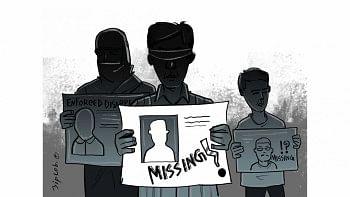Melodies on a monsoon evening

As a welcome rain brought respite to citizens on the first day of Asharh, the Bengali month of monsoon, a group of Tagore aficionados were assembling at the mezzanine floor gallery of the Daily Star-Bengal Arts Precinct in the capital, anticipating some melodies in tune with the mood of the evening. “Cholocchitrer Gaane Rabindranath” was the first musical event of Star Melodies to be hosted at the new precinct, featuring live performance of Tagore songs that have been adapted in films.
Star Arts & Entertainment Editor Sadya Afreen Mallick, who compered the programme, welcomed the guests and briefly dwelt on Star Melodies' past events, including the classical night where a hundred dancers of Nrittyanchal performed to classical music; Poncho-Kobi'r Gaan; adhunik songs of the 1960s, Folk music festival and later, tributes to Suchitra Sen and Bashir Ahmed, and seasonal melodies. She then went on to introduce the artistes of the night, as she discussed in brief the music of Tagore as it has been employed in films.
The music on offer was, in a word, top-notch. Mohiuzzaman Chowdhury set the evening rolling with “Ami Tomaye Joto Shuniyechilem Gaan” (“Mukti”, 1937), which Adity Mohsin and Fahim Hossain Chowdhury followed up with “Ghorete Bhromor Elo Gunguniye” (“Shuno Boronari”, 1960) and “Ki Paini Taar'i Hishab Milate” (“Daktar”, 1940) respectively. Adity Mohsin then sang “Bajilo Kaharo Beena” (“Agontuk”, 1991), Bulbul Ahmed marvelously rendered “Akash Bhora Shurjo Taara” (“Komol Gandhar”, 1961) followed by a Mohiuzzaman Chowdhury-Adity Mohsin duet of “Je Raate Mo'r Duarguli Bhanglo Jhor'e” (“Meghe Dhaka Taara”, 1960). Shama Rahman performed her first solo up next, the popular “Chander Hashi Badh Bhengeche” (“Udoyer Pothey”, 1944), and Laisa Ahmed Lisa sang “Ami Tomar Songe Bedhechi Amar Pran” (“Dharapat”, 1963). Although Kalim Sharafi, who directed music for “Dharapat”, is considered the first artiste from pre-Liberation Bangladesh to have playbacked a Tagore song, it was Fahmida Khatun who sang this song. The veteran artiste, present at the event, shared her memories of recording it, of how some restrictions imposed by Vishwa Bharati on the use of Tagore music were skirted around before the song could be put in the film. Sadya Afreen Mallick pointed out that the original Fahmida Khatun song had been removed from the film roll of “Dharapat” at the Bangladesh Film Archive, but a copy of it might be present somewhere else.
The music continued, with Fahim Hossain Chowdhury singing “Ami Chini Go Chini Tomare” (“Charulata”, 1964) and Bulbul Islam and Laisa Ahmed Lisa joining voices for “Tumi Robe Nirobe” (“Kuheli”, 1971). “Dibosh Rojoni Ami Jeno Kar” (“Nishante”, 1985) by Shama Rahman followed, while Mohiuzzman Chowdhury performed “Choron Dhorite Diyo Go Amare” (“Dada'r Kirti”, 1980). Laisa Ahmed Lisa crooned to the oozing romantic number “Bhalobashi, BhalobashI” (“Shwet Pathorer Thala”, 1992). The essence of monsoon was fittingly captured by Bulbul Islam in “Ami Tokhono Chhilem Mogono Gohono Ghumer Ghorey” (“Mohona”, 1982), with the closing performance being Fahim Hossain Chowdhury and Shama Rahman's blissful duet of “Mayabono Biharini”.
The informal arrangement, excellent lighting and the artistic ambiance of SM Sultan's paintings at the gallery (despite being a tad acoustically off-balance) and video clippings of the songs in the background, along with The Daily Star Executive Editor Syed Badrul Ahsan's humorous recollection of anecdotes about Tagore and his songs, kept the audience captivated the entire evening. As the event came to an end, those in attendance seemed keen on knowing when the next such coming-together was to be.
Eastern Bank Limited assisted in the programme, with concept and graphics support provided by Simantik Creative Concern and Sadya Afreen Mallick.

 For all latest news, follow The Daily Star's Google News channel.
For all latest news, follow The Daily Star's Google News channel. 



Comments